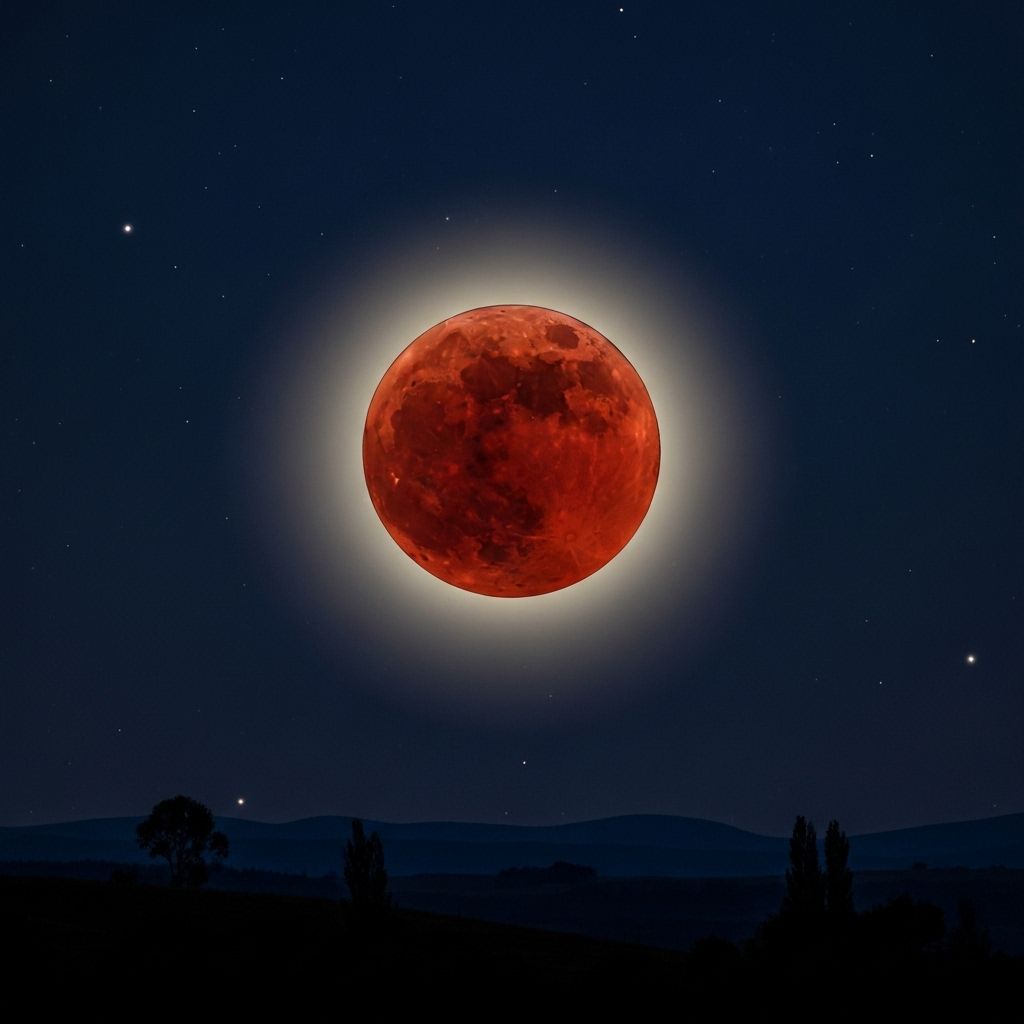Blood Moon Eclipse: Complete Guide To Causes, Dates, Viewing
Explore the science, folklore, and striking phenomena of the mysterious Blood Moon and lunar eclipses.

Image: HearthJunction Design Team
What Is a Blood Moon?
A Blood Moon is a captivating astronomical phenomenon that occurs during a total lunar eclipse, when Earth is positioned directly between the sun and the moon. In this alignment, the usually bright full moon transforms dramatically, taking on a deep red or rusty hue in the night sky. While the term ‘Blood Moon’ carries no unique scientific significance, its vivid appearance has inspired awe, myths, and scientific curiosity for centuries.
What Causes a Blood Moon?
Understanding the Blood Moon begins with the mechanics of a total lunar eclipse:
- Moon’s Position: A lunar eclipse only occurs during a full moon, but not every full moon results in an eclipse because the moon’s orbital path is slightly tilted compared to Earth’s orbit around the sun.
- Alignment: When the sun, Earth, and moon line up precisely, Earth blocks direct sunlight from illuminating the moon’s surface.
- Shadow Play: The moon passes through two types of Earth’s shadow:
- Penumbral Shadow: The outer part, causing subtle dimming.
- Umbra: The central, darkest part, where a total lunar eclipse—and Blood Moon—occurs.
Curious about other unique lunar events? Explore the fascinating world of lunar cycles, including the blue moon phenomenon, explained in detail in our comprehensive guide to blue moons. You'll uncover the history and meaning behind this rare occurrence.
As the moon enters the umbra, it does not go completely dark. Instead, Earth’s atmosphere bends and filters sunlight, allowing only the longer, red wavelengths to reach the lunar surface. This process, called Rayleigh scattering, is the same one responsible for colorful sunrises and sunsets.
Why Does the Moon Turn Red?
The dramatic color change during a total lunar eclipse is the result of physics in action. Here’s how it happens:
- Earth’s Atmosphere: During totality, sunlight passes through Earth’s thick atmosphere, which scatters the shorter blue and green wavelengths, allowing mainly red and orange hues to pass through and reach the moon.
- Filtering Effect: This indirect sunlight bathes the moon in a coppery red glow. The exact shade varies depending on atmospheric conditions, including:
- Cloud cover
- Dust, pollution, or smoke
- Volcanic ash
- Variable Colors: The moon can appear anything from a bright orange to a deep, blood-red or brown during a total lunar eclipse.
Quick Comparison: Blood Moon vs. Other Moon Phases
| Moon Name | Occurs During | Main Feature |
|---|---|---|
| Blood Moon | Total lunar eclipse | Moon appears red or copper |
| Supermoon | Full moon at perigee (closest to Earth) | Moon appears larger and brighter |
| Blue Moon | Second full moon in a calendar month | Rare extra full moon; color unchanged |
| Harvest Moon | Full moon closest to autumn equinox | Rises around sunset; useful for harvesting |
When Is the Next Blood Moon?
Blood Moons do not occur every year. Their timing is determined by the precise alignment of the sun, Earth, and moon. Here are the upcoming dates and recent history for these phenomenal events:
- Last Blood Moon: March 14, 2025
- Upcoming Blood Moons:
- September 7, 2025 (not visible in the Americas)
- March 3, 2026
- December 31, 2028
Lunar eclipses and Blood Moons are visible to anyone on the night side of Earth during the event, provided skies are clear. Unlike solar eclipses, you do not need special equipment to safely view a Blood Moon.
Other Types of Lunar Eclipses
- Partial Lunar Eclipse: Only part of the moon passes through Earth’s umbra, showing a black “bite” out of the disk.
- Penumbral Lunar Eclipse: The moon passes through Earth’s penumbral shadow, dimming slightly—a subtle effect, often missed by casual observers.
Only during a total lunar eclipse does the Blood Moon phenomenon reveal its full splendor.
Why Do Blood Moons Look Different?
The precise color and intensity of a Blood Moon can differ between eclipses. These variations are influenced by:
- Atmospheric Conditions: More dust, smoke, or volcanic ash leads to a deeper, darker red.
- Altitude of the Moon: The moon’s position in the sky can affect how much atmosphere the light travels through, altering its tint.
- Weather: Cloud cover can obscure the eclipse or subtly change its appearance.
- Pollution Levels: Heavily polluted urban areas may produce a darker moon.
Myths, Legends, and Folklore
Blood Moons have long inspired fascination and sometimes fear. Throughout history and across cultures, the red moon has been woven into myths and spiritual traditions:
- Ancient Civilizations: Associated Blood Moons with omens, warnings, or messages from the gods.
- Biblical References: The phrase “the moon will turn to blood” appears in some religious texts, fueling speculation and prophecy in popular culture.
- Native Traditions: Some North American peoples saw lunar eclipses as cosmic battles or times of renewal.
While science has dispelled many superstitions, the Blood Moon remains a favorite subject for skywatchers and storytellers alike.
How to Watch a Blood Moon
Experiencing a Blood Moon first-hand is safe and awe-inspiring. Here’s how to make the most of the next total lunar eclipse:
- Check the Date: Note upcoming total lunar eclipse dates for your location.
- Find a Good Spot: Choose an open area with minimal light pollution for the best view.
- Bring Binoculars or a Telescope: Optional—these help magnify the details, but the event is beautiful with the naked eye.
- Patience Pays Off: Lunar eclipses unfold over several hours; watch the full progression for the complete effect.
Remember: Unlike solar eclipses, no protective glasses are needed to view a lunar eclipse.
Frequently Asked Questions (FAQs)
Q: Is a Blood Moon dangerous to look at?
A: No, lunar eclipses—including Blood Moons—are completely safe to observe with the naked eye. Enjoy the spectacle without any protective gear!
Q: Why is it called a Blood Moon?
A: The vivid red or copper color of the moon during a total lunar eclipse inspired the nickname ‘Blood Moon.’ The term has been popularized in recent decades, though it’s not a scientific designation.
Q: Does a Blood Moon happen every year?
A: No, total lunar eclipses—and thus Blood Moons—do not happen every year. Sometimes several years can pass between events, depending on the alignment of the sun, Earth, and moon.
Q: What makes the moon’s color change so much?
A: The moon’s color during a total lunar eclipse depends on Earth’s atmosphere. Conditions such as dust, pollution, or clouds affect how much red light is scattered, influencing the moon’s hue.
Q: Are there any spiritual or scientific meanings behind Blood Moons?
A: Scientifically, a Blood Moon marks a total lunar eclipse with no special significance beyond the spectacle. Spiritually, many cultures have attached prophetic or mystical meanings—but these are symbolic, not factual.
Additional Resources
- Books: Explore Solar and Lunar Eclipses (Explore Outer Space) by Ruth Owen for children and curious adults.
- Web: Check NASA’s Space Place and other reputable astronomy sites for eclipse dates, viewing guides, and animations.
Whether you’re a seasoned astronomer or new to skywatching, the Blood Moon is one of nature’s most visually arresting and accessible celestial events. Mark your calendar for the next total lunar eclipse and experience the wonder for yourself!
References
Read full bio of Shinta











